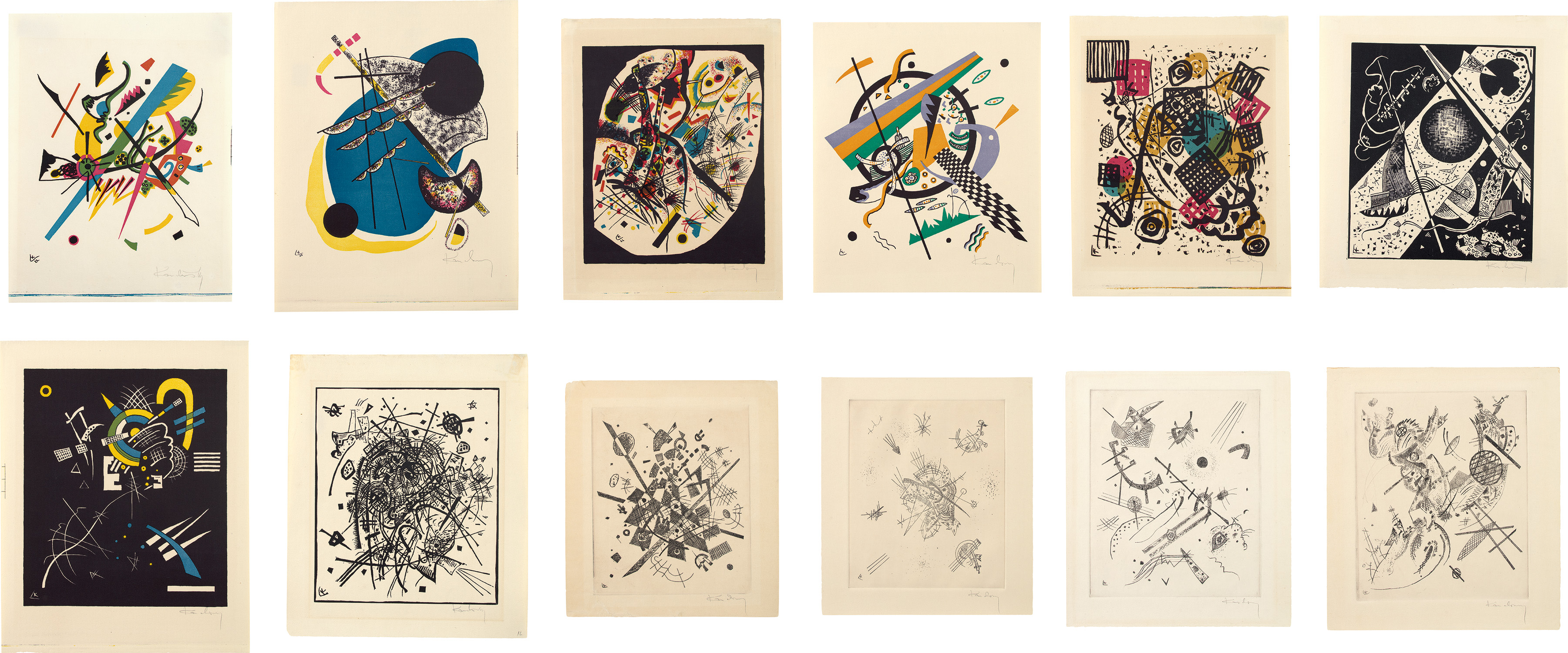

Property from an American Collection
17
Wassily Kandinsky
Kleine Welten (Little Worlds)
1922
The set of 12 prints, including four lithographs in colors, two woodcuts in colors and two in black, and four drypoints, on various wove papers, most with full margins, contained in an original green half-leather folio with yellow paper sides with the cover vignette on the front and the title and artist's name in gilt on the spine.
all I. various sizes
all S. lithos and woodcuts approximately 14 x 11 in. (35.6 x 27.9 cm)
all S. etchings approximately 12 x 10 1/2 in. (30.5 x 26.7 cm)
all S. lithos and woodcuts approximately 14 x 11 in. (35.6 x 27.9 cm)
all S. etchings approximately 12 x 10 1/2 in. (30.5 x 26.7 cm)
All signed in pencil, from the total edition of 230, published by Propyläen Verlag, Berlin, printed at the Staatliches Bauhaus, Weimar, all unframed.
Full-Cataloguing
Full of geometric precision, Wassily Kandinsky’s Kleine Welten (Little Worlds) is a portfolio comprised of twelve prints divided evenly into drypoints, woodcuts, and lithographs. With an emphasis on craft, the prints were made shortly after Kandinsky began teaching at the influential Bauhaus school in Weimar, Germany. In the portfolio, each printing technique employed was chosen by Kandinsky specifically for its unique qualities. Kandinsky preferred drypoint over other methods of intaglio printing because of its “haste” and “incisive character.” He liked woodcut because of the simple forms and rich textures it could efficiently produce. And finally, he enjoyed lithography, a 'modern medium' that allowed for a quick and smooth process, eliminating strenuous effort.
In this portfolio, each print’s self-contained composition brings to a mind a ‘little world’ bursting with cosmic energy, by way of floating geometrical shapes, dissolving checkerboards, and wavy lines. The prints radiate in rhythmic configurations, rich in texture and mark-making. Kleine Welten (Little Worlds) captures the potential Kandinsky saw for a coming together of traditional printmaking techniques into one portfolio, all exploring the same subject matter through varied tools.
Introduced in the 19th century, the German term Gesamtkunstwerk or 'total work of art', expressed the need for a synthesis within the arts, the creation of a more comprehensive work. Kandinsky saw this 'combined art' as beneficial to the spirit, “every man who steeps himself in the spiritual possibilities of this [total work of art] is a valuable helper in the building of the spiritual pyramid which will someday reach to heaven," said Kandinsky. He believed that the only way to create works that would be truly monumental was by considering the total work. In Kandinsky’s oeuvre of printmaking, Kleine Welten (Little Worlds) is monumental and is an incarnation of the spiritual.
"Kandinsky grew to perfection as naturally as a fruit develops and ripens. Anyone not resisting nature will become beauty and spirit. In time and space, those divine mirrors, his work is aglow with spiritual reality. Kandinsky loved life, he was intoxicated with the riches of earth and sky....Things blossom, sparkle, ripple in his paintings and poems. They speak of old blood and young stones." Jean Arp, Hans Arp, Stone Formed by the Human Hand, 1948, p. 242
In this portfolio, each print’s self-contained composition brings to a mind a ‘little world’ bursting with cosmic energy, by way of floating geometrical shapes, dissolving checkerboards, and wavy lines. The prints radiate in rhythmic configurations, rich in texture and mark-making. Kleine Welten (Little Worlds) captures the potential Kandinsky saw for a coming together of traditional printmaking techniques into one portfolio, all exploring the same subject matter through varied tools.
Introduced in the 19th century, the German term Gesamtkunstwerk or 'total work of art', expressed the need for a synthesis within the arts, the creation of a more comprehensive work. Kandinsky saw this 'combined art' as beneficial to the spirit, “every man who steeps himself in the spiritual possibilities of this [total work of art] is a valuable helper in the building of the spiritual pyramid which will someday reach to heaven," said Kandinsky. He believed that the only way to create works that would be truly monumental was by considering the total work. In Kandinsky’s oeuvre of printmaking, Kleine Welten (Little Worlds) is monumental and is an incarnation of the spiritual.
"Kandinsky grew to perfection as naturally as a fruit develops and ripens. Anyone not resisting nature will become beauty and spirit. In time and space, those divine mirrors, his work is aglow with spiritual reality. Kandinsky loved life, he was intoxicated with the riches of earth and sky....Things blossom, sparkle, ripple in his paintings and poems. They speak of old blood and young stones." Jean Arp, Hans Arp, Stone Formed by the Human Hand, 1948, p. 242